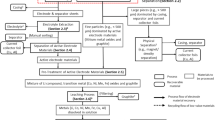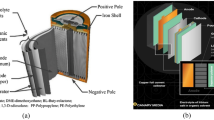Abstract
Lithium ion batteries (LIBs) are an essential energy-storage device for a majority of advanced electronics used in our everyday lives, from cell phones and laptops, to medical devices and electric vehicles. Despite their continued widespread adoption, methods to recycle and reuse end-of-life (EOL) LIB materials are still under active development. In the first part of this two-part review on LIB recycling, we review current commercial scale processes in practice for recycling or reusing EOL LIB components. Future waste projections estimate 4 million tons of cumulative EOL EV battery modules by 2030, which is above the current global recycling capacity. All of the processes in use today utilize a combination of pyrometallurgical and hydrometallurgical or mechanical and hydrometallurgical processing to recover mainly cobalt and nickel and copper, while other components are disposed as waste unless further processed. In this review, we highlight the need for recycling LIB material components based on resource availability and the current processes in practice to recover and recycle LIBs.








Similar content being viewed by others
References
Blomgren GE (2017) The development and future of lithium ion batteries. J Electrochem Soc 164:5019–5025. https://doi.org/10.1149/2.0251701jes
Mizushima K, Jones PC, Wiseman PJ, Goodenough JB (1981) 2-LixCoO2 (0). Solid State Ionics 3–4:171–174. https://doi.org/10.1016/0167-2738(81)90077-1
Yoshino A, Sanechika K, Nakajima T (1987) Secondary battery. Asahi Kasei Corp. U.S. Patent 4,668,595
Yoshino A (2012) The birth of the lithium-ion battery. Angew Chemie Int Ed 51:5798–5800. https://doi.org/10.1002/anie.201105006
Nitta N, Wu F, Lee JT, Yushin G (2015) Li-ion battery materials: present and future. Mater Today 18:252–264. https://doi.org/10.1016/j.mattod.2014.10.040
Molenda J, Mole M (2011) Composite cathode material for Li-ion batteries based on LiFePO4 system. In: Metal, ceramic and polymeric composites for various uses. InTech, Rijeka
Deng D (2015) Li-ion batteries: basics, progress, and challenges. Energy Sci Eng 3:385–418. https://doi.org/10.1002/ese3.95
Bryner M, Clarke GM, Jansen AM, et al (2013) Lithium-ion batteries. Chem Eng Prog 35–64
Perdu F (2016) Overview of existing and innovative batteries. In: Science and energy seminar. e-EPS, Les Houches
Bloomberg New Energy Finance (2017) Electric vehicle outlook 2017
Curry C (2017) Lithium-ion battery costs and market. Bloomberg New Energy Finance. https://data.bloomberglp.com/bnef/sites/14/2017/07/BNEF-Lithium-ion-batterycosts-and-market.pdf. Accessed 12 July 2019
Pillot C (2017) The rechargeable battery market and main trends 2016–2025. In: International battery seminar & exhibit, March 20th. https://www.avicenne.com/pdf/Fort_Lauderdale_Tutorial_C_Pillot_March2015.pdf. Accessed 30 May 2019
Song C, Wang W, Peng H, et al (2018) Improving the electrochemical performance of LiNi0.80Co0.15Al0.05O2 in lithium ion batteries by LiAlO2 surface modification. Appl Sci 8:378. https://doi.org/10.3390/app8030378
Sverdrup HU, Ragnarsdottir KV, Koca D (2017) An assessment of metal supply sustainability as an input to policy: security of supply extraction rates, stocks-in-use, recycling, and risk of scarcity. J Clean Prod 140:359–372. https://doi.org/10.1016/j.jclepro.2015.06.085
Lee Bray E (2018) Bauxite and alumina. US Geol Surv Miner Commod Summ, pp 30–31
Shedd K (2018) Cobalt. US Geol Surv Miner Commod Summ, pp 50–51
Flanagan D (2018) Copper. US Geol Surv Miner Commod Summ, pp 52–53
Tuck C (2018) Iron ore. US Geol Surv Miner Commod Summ, pp 88–89
Jaskula B (2018) Lithium. US Geol Surv Miner Commod Summ, pp 98–99. https://doi.org/10.3133/70194932
Corathers L (2018) Manganese. US Geol Surv Miner Commod Summ, pp 104–105. https://doi.org/10.3133/70194932
Olson D (2018) Graphite (Natural). US Geol Surv Miner Commod Summ, pp 72–73
McRae M (2018) Nickel. US Geol Surv Miner Commod Summ, pp 112–113
Jasinski S (2018) Phosphate rock. US Geol Surv Miner Commod Summ, pp 122–123
Schnebele E (2018) Silicon. US Geol Surv Miner Commod Summ, pp 148–149
Schuyler Anderson C (2018) Tin. US Geol Surv Miner Commod Summ, pp 172–173
Bedinger G (2018) Titanium mineral concentrates. US Geol Surv Miner Commod Summ, pp 176–177. https://doi.org/10.3133/70194932
Martin G, Rentsch L, Höck M, Bertau M (2017) Lithium market research—global supply, future demand and price development. Energy Storage Mater 6:171–179. https://doi.org/10.1016/j.ensm.2016.11.004
Helbig C, Bradshaw AM, Wietschel L et al (2018) Supply risks associated with lithium-ion battery materials. J Clean Prod 172:274–286. https://doi.org/10.1016/j.jclepro.2017.10.122
Chohan UW (2018) Blockchain and the extractive industries: cobalt case study. Available at SSRN: https://ssrn.com/abstract=3138271. Accessed 12 July 2019
Moradi B, Botte GG (2016) Recycling of graphite anodes for the next generation of lithium ion batteries. J Appl Electrochem 46:123–148. https://doi.org/10.1007/s10800-015-0914-0
Yang Q, Geng Y, Dong H et al (2017) Effect of environmental regulations on China’s graphite export. J Clean Prod 161:327–334. https://doi.org/10.1016/j.jclepro.2017.05.131
Jara AD, Betemariam A, Woldetinsae G, Kim JY (2019) Purification, application and current market trend of natural graphite: a review. Int J Min Sci Technol. https://doi.org/10.1016/j.ijmst.2019.04.003
Klemola K (2016) Life-cycle impacts of tesla model S 85 and volkswagen passat. Online Report: http://kimmoklemola.fi/data/documents/SF-comparison-USA-20160110.pdf. Accessed 12 July 2019
ELIBAMA project (2014) Li-ion batteries recycling. In: Electrodes and cells manufacturing white paper. ELIBAMA project, pp 239–264
Foster M, Isely P, Standridge CR, Hasan MM (2014) Feasibility assessment of remanufacturing, repurposing, and recycling of end of vehicle application lithium-ion batteries. J Ind Eng Manag 7:698–715. https://doi.org/10.3926/jiem.939
Tedjar F, Foudraz J-C (2010) Method for the mixed recycling of lithium-based anode batteries and cells. U.S. Patent No. US 7,820,317
Kang DHP, Chen M, Ogunseitan OA (2013) Potential environmental and human health impacts of rechargeable lithium batteries in electronic waste. Environ Sci Technol 47:5495–5503. https://doi.org/10.1021/es400614y
Zeng X, Li J, Singh N (2014) Recycling of spent lithium-ion battery: a critical review. Crit Rev Environ Sci Technol 44:1129–1165. https://doi.org/10.1080/10643389.2013.763578
Larsson F, Andersson P, Blomqvist P, Mellander BE (2017) Toxic fluoride gas emissions from lithium-ion battery fires. Sci Rep 7:1–13. https://doi.org/10.1038/s41598-017-09784-z
Dunn JB, Gaines L, Barnes M, Sullivan J, Wang M (2014) Material and energy flows in the materials production, assembly, and end-of-life stages of the automotive lithium-ion battery life cycle (No. ANL/ESD/12-3 Rev.). Argonne National Laboratory (ANL), Argonne
Romare M, Dahllöf L (2017) The life cycle energy consumption and greenhouse gas emissions from lithium-ion batteries: a study with focus on current technology and batteries for light-duty vehicles. IVL Swedish Environmental Research Institute, Stockholm
Notter DA, Gauch M, Widmer R et al (2010) Contribution of Li-ion batteries to the environmental impact of electric vehicles. Environ Sci Technol 44:6550–6556. https://doi.org/10.1021/es903729a
Dewulf J, Van der Vorst G, Denturck K et al (2010) Recycling rechargeable lithium ion batteries: critical analysis of natural resource savings. Resour Conserv Recycl 54:229–234. https://doi.org/10.1016/j.resconrec.2009.08.004
Heelan J, Gratz E, Zheng Z et al (2016) Current and prospective Li-ion battery recycling and recovery processes. Jom 68:2632–2638. https://doi.org/10.1007/s11837-016-1994-y
Gu F, Guo J, Yao X et al (2017) An investigation of the current status of recycling spent lithium-ion batteries from consumer electronics in China. J Clean Prod 161:765–780. https://doi.org/10.1016/j.jclepro.2017.05.181
Nowak S, Winter M (2017) The role of sub- and supercritical CO2 as “processing solvent” for the recycling and sample preparation of lithium ion battery electrolytes. Molecules 22:403. https://doi.org/10.3390/molecules22030403
Ellis T, Mirza A (2015) Battery recycling: defining the market and identifying the technology required to keep high value materials in the economy and out of the waste dump. https://www.researchgate.net. Accessed 30 May 2019
Saloojee F, Lloyd J (2015) Lithium battery recycling process. Department of Environmental affairs Development Bank of South Africa (Project No. DB-074 (RW1/1016))
Zeng X, Li J, Liu L (2015) Solving spent lithium-ion battery problems in China: opportunities and challenges. Renew Sustain Energy Rev 52:1759–1767. https://doi.org/10.1016/j.rser.2015.08.014
De-Leon S (2018) Lithium ion battery recycling market 2018. Shumuel De-Leon Energy Ltd, Hod-Hasharon
Yazicioglu B, Tytgat J (2011) Life cycle assessments involving umicore’s battery recycling process. In: DG Environment–Stakeholder Meeting, Umicore
Cheret D, Santen S (2007) Battery recycling. U.S. Patent No. 7,169,206
Gaines L (2014) The future of automotive lithium-ion battery recycling: charting a sustainable course. Sustain Mater Technol 1:2–7. https://doi.org/10.1016/j.susmat.2014.10.001
Sonoc A, Jeswiet J, Soo VK (2015) Opportunities to improve recycling of automotive lithium ion batteries. Procedia CIRP 29:752–757. https://doi.org/10.1016/j.procir.2015.02.039
Georgi-Maschler T, Friedrich B, Weyhe R et al (2012) Development of a recycling process for Li-ion batteries. J Power Sources 207:173–182. https://doi.org/10.1016/j.jpowsour.2012.01.152
Weyhe R. International Energy Agency Photovoltaic Power System Programme, Accurec Recycling Gmbh. http://ieapvps.org/fileadmin/dam/public/workshop/10_Reiner_Thomas_WEYHE.pdf. Accessed 12 July 2019
McLaughlin W, Adams TS (1999) Li reclamation process. U.S. Patent No. 5,888,463
Zenger T, Krebs A, van Deutekom HJH (2010) Method of and apparatus for dismantling and storage of objects comprising alkali metals, such as alkali metal containing batteries. U.S. Patent No. 7,833,646
Sloop, Steven E, Parker R (2011) System and method for processing and end-of-life or reduced performance energy storage and/or conversion device using a supercritical fluid. U.S. Patent No. 8,067,107
Diekmann J, Hanisch C, Frob L et al (2017) Ecological recycling of lithium-ion batteries from electric vehicles with focus on mechanical processes. J Electrochem Soc 164:6184–6191. https://doi.org/10.1149/2.0271701jes
Gaines L (2018) Lithium-ion battery recycling processes: research towards a sustainable course. Sustain Mater Technol 17:e00068. https://doi.org/10.1016/j.susmat.2018.e00068
Julien CM, Mauger A, Zaghib K, Groult H (2014) Comparative issues of cathode materials for Li-ion batteries. Inorganics 2:132–154. https://doi.org/10.3390/inorganics2020132
Author information
Authors and Affiliations
Corresponding author
Ethics declarations
Conflict of interest
On behalf of all authors, the corresponding author states that there is no conflict of interest.
Additional information
The contributing editor for this article was Brajendra Mishra.
Publisher's Note
Springer Nature remains neutral with regard to jurisdictional claims in published maps and institutional affiliations.
Rights and permissions
About this article
Cite this article
Pinegar, H., Smith, Y.R. Recycling of End-of-Life Lithium Ion Batteries, Part I: Commercial Processes. J. Sustain. Metall. 5, 402–416 (2019). https://doi.org/10.1007/s40831-019-00235-9
Received:
Revised:
Accepted:
Published:
Issue Date:
DOI: https://doi.org/10.1007/s40831-019-00235-9




